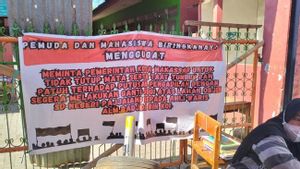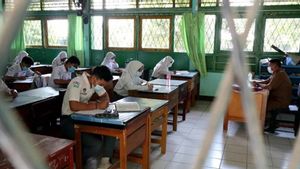JAKARTA The clothes worn by Indonesian athletes at the opening ceremony of the 2024 Paris Olympics in Paris, Friday (26/7/2024) became a hot topic of conversation among netizens. But on the other hand, the traditional clothes used by the Indonesian contingent are considered Javancentric.
The Indonesian contingent wore Javanese traditional clothes during the opening parade of the 2024 Paris Olympics which was held on the SEEne River. This is the first time the Olympics have been held outside the stadium.
Being on the boat that trailed the Seane River, the Indonesian contingent was represented by 14 people, including Chef de Mission (CdM) Anindya Bakrie, judo athlete Maryam March Maharani, cycling athlete Bernand Benjamin van Aert, and two swimmers namely Azzahra Permatahani and Joe Aditya.
Female athletes wear red Kutukbaru Kebaya, while male athletes wear beskap and blangkon tops. Both female and male athletes both wear white subordinates.
Clothing used during the parade is the work of Indonesian designer Ragowo Hediprasetyo Djojohadikusumo or better known as Didit Prabowo. The son of the President-elected RI Prabowo Subianto admitted that he was inspired by the painter of a romanticism from Java, Raden Saleh.
"I am so grateful to be able to design the official uniform of the opening parade for the athletes representing Indonesia at the 2024 Olympics in Paris," said Didit.
However, traditional clothing worn during the opening parade of the 2024 Paris Olympics was branded by Jawacentric for displaying traditional Javanese clothing.
In his written statement, Didit explained that his work costumes provide a new perspective on designs that prioritize the athlete's excellent performance with cultural wealth.
The inspiration is Raden Saleh, a modern art painter who comes from ethnic Arab-Java. His journey from Central Java to the European palace in the 19th century which reflected the rise of the Indonesian people in the international arena. His paintings also graced the walls of Rijksmuseum and Louvre, and were considered to represent a combination of Javanese culture and European romance that Didit applied elegantly.
"My hope is that this design will be a form of national pride, enthusiasm, and resilience. At the same time ensure that every athlete appears as the best when competing later," said Didit.
Not only pampering visuals, this costume design also prioritizes the needs of athletes. This can be seen from the uniforms made with high quality materials to provide maximum comfort and easy movement.
This costume uses braathable materials such aswashed-outdemics, velvettes, and jerseys to dominate the main color. Male athlete uniforms are inspired by the jacket and combined with beskap. Then white trousers complete the appearance.
Meanwhile, the female athlete uniform uses a Kebaya Kutubaru superior who is paired with a jumpsuit. This uniform combines elements of support with elegant splendor.
Attention to detail is evident in each design, ranging from complicated stitches to the placement of a fine red and white Indonesian emblem made of skin, as well as a contemporary touch on the blangkon, a Javanese traditional male head decoration that uses skin and denim materials.
Although he did not participate in the parade contingent, the Chairman of the Indonesian Olympic Committee (NOC Indonesia) Raja Sapta Oktohari also had the opportunity to wear the same clothes as the Indonesian team parade participants.
The opening ceremony of the Olympics is the best opportunity to introduce Indonesia as a great nation. Moreover, I and other Indonesian parade teams wore the work of Indonesian designers who have been recognized by the world. We should Banggsa," said Okto.
Not only designing costumes for parades, Didit Hediprasetyo also designed the jerseys worn by athletes when competing in the quadrennial event. For this Red and White jersey, the 1984-born man admitted that he was inspired by the song Berkibarlah My Flag.
When the Olympic parade costume was announced, not a few netizens criticized the designer's selection of Javanese traditional clothes. Too Javantris, he said, because Indonesia is considered to have only introduced Javanese culture in international events.
However, the allegation is refuted that in the previous five editions, Indonesia wore traditional clothes from various regions.
SEE ALSO:
At the 2020 Tokyo Olympics, surfer Rio Waida wore Balinese Payas Madya traditional clothes when he was trusted to be the bearer of the Red and White flag at the opening ceremony. Then at the 2016 Rio Olympics it was the turn of the traditional Lampung clothes worn by Indonesian representatives at the opening ceremony. Eight years ago, it was the turn of the athlete to jump far away from Maria Natalia Londa who received the honor of being the bearer of the Indonesian flag in traditional Lampung clothes.
The Indonesian contingent appeared in traditional Jakarta clothing when the 2012 Olympics were held in London, England. And further back, to be precise at the Olympics in Beijing, the Indonesian contingent wore traditional Malay clothing from Sumatra.
The Olympics and culture are always in line, because these events are often an opportunity to show off the culture of a country. Not only Indonesia, this is also done by other countries.
Citing the 2024 Paris Olympics, Ukraine opened a hospitality house, which will hold concerts and promote local culture including traditional Ukrainian food. The hospitality house is also opened to raise world awareness about the war with Russia.
The opening of the Ukraine hospitality house begins with the national anthem and a moment of silence in memory of the soldiers who have fallen on the battlefield.
"We will celebrate a culture that is trying to be destroyed by someone," said French Sports Minister Amelie Oudea-Custera, referring to Russia. "Here you will be safe, you will be happy and celebrate."
The house is dubbed Volcana Space, which is taken from Ukraine's unique word which means will and freedom at once, according to a description on its official website.
Fans who come in a state of hunger can taste the traditional Ukrainian soup, bolisht, which is declared an intangible cultural heritage by UNESCO.
Hospitality houseUkraine is one of 15clubhousetimas at Parc de la Villette, a world exhibition held on the outskirts of Paris.
The English, Chinese, Japanese, Arabic, and French versions are automatically generated by the AI. So there may still be inaccuracies in translating, please always see Indonesian as our main language. (system supported by DigitalSiber.id)














